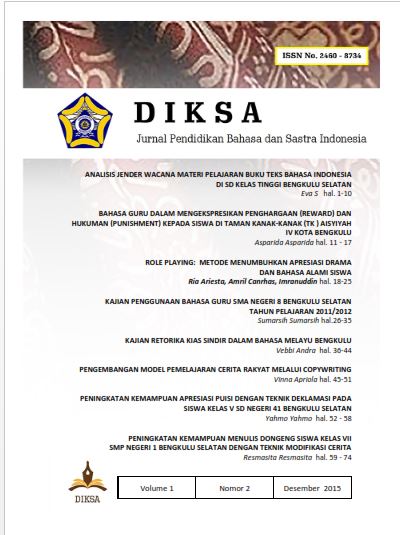Main Article Content
Abstract
This study aims to find out, how the analysis of bilingualism on Supernova novel Akar by Dewi Lestari specifically examine 1) How is the form of switch code on Novel Supernova Akar by Dewi Lestari 2) How is the form of mixed code on Novel Supernova Akar by Dewi Lestari 3) How the function context of switch code on Novel Supernova Akar by Dewi Lestari 4) How the function context of mixing code on Novel Supernova Akar by Dewi Lestari. The research data in the form of words in the novel Supernova Akar by Dewi Lestari and the source data used in this study is novel literary work entitled Supernova Akar by Dewi Lestari. The method used in this research is descriptive method. Data collection techniques used are documentation and recording techniques. The products of this research isthe use of bilingualism in Novel Supernova Akar by Dewi Lestari, formof switch codethat is used by a speaker and two speakers, mixed forms are used in order to cool the code, follow the trend, educational exhibit, showing the position and function of the context of the use of switch code and mixed code that is a) transactional function, namely the function of language to tell something to the listener ( to do something), and b) interactional function is linguistic function to maintenance social relathionship, example to negociate role relations, people with the same age solidarity, ship exchange on conversation, saving face to speaker or listener.
Keywords
Article Details
Authors who publish with this journal agree to the following terms:
- Authors retain copyright and grant the journal right of first publication with the work simultaneously licensed under a Creative Commons Attribution License that allows others to share the work with an acknowledgment of the work's authorship and initial publication in this journal.
- Authors are able to enter into separate, additional contractual arrangements for the non-exclusive distribution of the journal's published version of the work (e.g., post it to an institutional repository or publish it in a book), with an acknowledgment of its initial publication in this journal.
- Authors are permitted and encouraged to post their work online (e.g., in institutional repositories or on their website) prior to and during the submission process, as it can lead to productive exchanges, as well as earlier and greater citation of published work (See The Effect of Open Access).
References
- Alwasilah, Chaedar. 1989. Sosiologi Bahasa. Bandung: Angkasa.
- Chaer, Abdul. Dkk. 1991. Sosiolinguistik Perkenalan Awal. Jakarta: Rineka Cipta.
- Halim, Abdul. 2011. Metodologi Penelitian Bahasa. Jakarta: Diadit Media Press.
- Keraf, Gorys. 1981. Diksi dan Gaya Bahasa. Jakarta: Gramedia Pustaka Utama.
- Kosasih. 2012. Dasar-dasar Keterampilan Bersastra Bandung : Yrama Widya.
- Kridalaksana, Harimurti. 2010. Kamus Linguistik. Jakarta: Gramedia Pustaka Utama.
- Lestari, Dewi.2002. Supernova(Akar). Bandung: Trudee Books.
- Mahsun. 2005. Metode Penelitian Bahasa : Tahapan Strategi, Metode, dan Tekniknya. Jakarta: Grafindo Persada.
- Moleong, Lexy.K. 2007. Metode Penelitian Kualitatif. Bandung: Remaja Rosda Karya.
- Nababan, P.W.J. 1984. Sosiolinguistik Suatu Pengantar. Jakarta: Gramedia.
- Nurgiyantoro, Burhan. 2010. Teori Pengkajian Fiksi. Yogyakarta: Gajah Mada University Press.
- Pateda, Mansoer. 1987. Sosiolinguistik. Bandung: Angkasa.
- Pusat Pembinaan dan Pengembangan Bahasa. 2003. Kamus Besar Bahasa Indonesia. Jakarta: Balai Pustaka.
- Rahardi, Kunjana. 2001. Sosiolinguistik, Kode dan Alih Kode. Yogyakarta: Pustaka Pelajar.
- Samsuri. 1987. Analisis Bahasa. Jakarta: Erlangga.
- Sudaryanto. 1994. Pemanfaatan Potensi Bahasa. Yogyakarta: Gadjah Mada University Press.
- Susetyo. 2009. Menulis Akademik. Bengkulu: FKIP Universitas Bengkulu.
- Sumarsono dan Paina Pertama. 2002. Sosiolinguistik. Yogyakarta: Sabda dan Pustaka Belajar.
- Suwito. 1983.Sosiolinguistik: Terapan dan Problema. Solo: Henari Offse.
- Syukur, Abdul. 1995. Sosiolinguistik. Surabaya: Usaha Nasional.
- Tarigan, Henry Guntur. 1986. Pengajaran Kedwibahasaan. Bandung: Angkasa.
- Wahyuningtyas, Sri dan Wijaya Heru. 2010. Pengantar Apresiasi Prosa. Surakarta: Yuma Pustaka.
- Yule, George dkk. 1996. Analisis Wacana. Jakarta: Gramedia Pustaka Utama.
References
Alwasilah, Chaedar. 1989. Sosiologi Bahasa. Bandung: Angkasa.
Chaer, Abdul. Dkk. 1991. Sosiolinguistik Perkenalan Awal. Jakarta: Rineka Cipta.
Halim, Abdul. 2011. Metodologi Penelitian Bahasa. Jakarta: Diadit Media Press.
Keraf, Gorys. 1981. Diksi dan Gaya Bahasa. Jakarta: Gramedia Pustaka Utama.
Kosasih. 2012. Dasar-dasar Keterampilan Bersastra Bandung : Yrama Widya.
Kridalaksana, Harimurti. 2010. Kamus Linguistik. Jakarta: Gramedia Pustaka Utama.
Lestari, Dewi.2002. Supernova(Akar). Bandung: Trudee Books.
Mahsun. 2005. Metode Penelitian Bahasa : Tahapan Strategi, Metode, dan Tekniknya. Jakarta: Grafindo Persada.
Moleong, Lexy.K. 2007. Metode Penelitian Kualitatif. Bandung: Remaja Rosda Karya.
Nababan, P.W.J. 1984. Sosiolinguistik Suatu Pengantar. Jakarta: Gramedia.
Nurgiyantoro, Burhan. 2010. Teori Pengkajian Fiksi. Yogyakarta: Gajah Mada University Press.
Pateda, Mansoer. 1987. Sosiolinguistik. Bandung: Angkasa.
Pusat Pembinaan dan Pengembangan Bahasa. 2003. Kamus Besar Bahasa Indonesia. Jakarta: Balai Pustaka.
Rahardi, Kunjana. 2001. Sosiolinguistik, Kode dan Alih Kode. Yogyakarta: Pustaka Pelajar.
Samsuri. 1987. Analisis Bahasa. Jakarta: Erlangga.
Sudaryanto. 1994. Pemanfaatan Potensi Bahasa. Yogyakarta: Gadjah Mada University Press.
Susetyo. 2009. Menulis Akademik. Bengkulu: FKIP Universitas Bengkulu.
Sumarsono dan Paina Pertama. 2002. Sosiolinguistik. Yogyakarta: Sabda dan Pustaka Belajar.
Suwito. 1983.Sosiolinguistik: Terapan dan Problema. Solo: Henari Offse.
Syukur, Abdul. 1995. Sosiolinguistik. Surabaya: Usaha Nasional.
Tarigan, Henry Guntur. 1986. Pengajaran Kedwibahasaan. Bandung: Angkasa.
Wahyuningtyas, Sri dan Wijaya Heru. 2010. Pengantar Apresiasi Prosa. Surakarta: Yuma Pustaka.
Yule, George dkk. 1996. Analisis Wacana. Jakarta: Gramedia Pustaka Utama.
